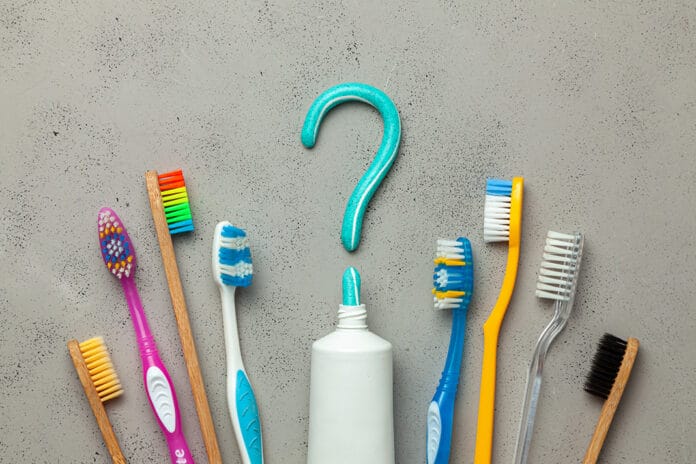As a dental hygienist, how are you choosing toothbrushes for dental patients? We all go for the obvious, should it be a manual, battery, or electric model. For some, manual brushes are the best option due to finances, patient preference, or because they have great efficacy with a manual brush.
In my particular area of practice, greater than 90% are currently using a manual toothbrush. It has taken months of using different toothbrush styles each for a week, but I now know that each brush has something different to offer. Taking notes on each brush, both feel in the hand and mouth, as well as plaque scores, gave some great insight into the nuances of each style and adaptation. It takes knowledge and awareness of patients’ needs to choose the best brush.
Your dental practice may offer several different brush options to hand out, but the choice(s) may not always be the best one for a patient.
Analyzing Toothbrush Styles
Having several different style options for patients to see and feel will sometimes help them be better prepared to shop for their own toothbrush. Note how each style can be completely different to virtually identical. Many manufacturers offer sample packs of various style options, which can really help patients discover the best brush for them, as well as aid the practitioner in guiding the patient to the most effective and comfortable option.
Handle design ‒ What feels best in the patient’s hand? Are there any limiting factors such as arthritis? Limited grip strength? Neuropathy? For those types of issues, a larger, textured, and soft-grip may allow for a firmer and more confident grip.
Handles range from thin and smooth hard plastic all the way to very textured, soft, spongy, thick grips with various added textural elements such as bands, dots, and squiggles of different materials. What feels best in the hand will increase brushing time in the mouth and allow for the best angulation control.
Bristles ‒ The bristles must feel good in the mouth, or the brush will be associated with discomfort or an unpleasant sensation. Most manual brushes range from extra soft, soft, and medium, and most bristle options are available in the various handle designs.
Each individual bristle can also be shaped differently ‒ rounded, feather-like, or flat ‒ offering a different feel in the mouth. Some brushes provide multiple types of bristles and shapes in one brush head. Some advertise that soft feather-like bristles feel more gentle, flat bristles feel firmer, or rounded tips are said to be gentler overall.
I found the bristle material to make a larger impact on overall sensation. The wider synthetic bristle felt more “prickly” and harder, almost like a thick plastic versus the thin soft bristle that was easily contoured to the tissue.
Most brushes can be made to feel softer by brushing with warm water, which helps lessen some patients’ perception of “prickly” bristles.
Brush head ‒ The style of the brush head completely changes the efficacy and feel for the patient. It is not simply the ultra-compact, compact, or full option that makes a difference, but the actual shape of the brush head.
There are rounded tops, very narrow brush heads, wide styles, short, long, domed, flat, rounded, crossed bristle, high low, and hybrid combinations of multiple options. While overall patient comfort is important to increase brushing times, each brush head style is designed with a different mouth shape in mind. Smaller mouths do well paired with a more compact, rounded, narrow brush head, as do those with a limited opening. Larger mouths or those with third molars do well with a longer, wider multi-row brush head to allow access to the distal of the thirds.
Patients with looser cheeks seem to find that a wide brush head will deflect the cheek back enough so that the teeth can be more easily reached. Patients in traditional orthodontics do well with a very narrow, simple short brush head to thoroughly access above and below the bracket.
It truly is amazing to see all the various combinations of styles designed for overall comfort, accessibility, and efficacy.
Appearance ‒ Does the patient have a color preference? Pastels, bolds, and multicolored options abound. Many manufacturers appear to target the bold, multicolored styles toward teens and the mild, simple colors toward periodontal therapy patients. Handle designs often add more intricate color combinations with rings and textured patterns, but many bristle styles come in multicolored options as well.
The patient’s perception of the brush does make a difference for some and can make for a more pleasurable experience, also enhancing brush times.
Packaging ‒ Then, we have the packaging and sustainability preferences. Does your patient prefer a bamboo brush wrapped in sustainable packaging? There are multiple options for wooden handle brushes with different shaped brush tips.
The bamboo brushes have fewer handle options in mainly size and width, but the bristles themselves feel very delicate in the mouth and quite smooth. The texture leaves a very pleasant mouth feel while being just as effective in plaque removal.
Narrowing Down the Choices
Get to know patients’ preferences by asking a few questions and then begin to make recommendations.
For me, it was shocking to learn that so much science and research goes into the design of a manual toothbrush. First is the idea of a design, then a draft with multiple prototypes created. This alone can take months, and then it must be studied for efficiency and safety before ever seeing a patient’s mouth.
While working with a very large group of individuals with diverse needs, I needed multiple toothbrush options that would feel gentle and meet completely different hand and mouth requirements, as well as appeal to different ages and personality styles. I tried about 35 different brushes in my own mouth, one for each week. It was clear that each brush did have a different mouth feel and elicited a reaction from wildly positive to absolutely uncomfortable. For me, hard plastic handles, when wet, feel slippery and offer little control. Some of the more intricate textured handles felt really large in my hand. Some bristles felt rough on the tissue, and some felt so soft that plaque removal felt impaired.
Try each of the brush options that you currently offer patients and acquaint yourself with the attributes so you can best offer recommendations.
Consider requesting multiple samples of different styles to allow patients to touch and familiarize themselves with the options before heading into a store and potentially becoming overwhelmed. Many manufacturers will send a sample pack when requested. Try attending a dental conference for multiple options. Manufacturers want professionals to try their products in hopes that we recommend them for patient use. Toothbrushes are not one-size-fits-all, and perhaps your help in choosing the most comfortable one will enhance your patient’s toothbrushing experience, creating a healthier outcome.












